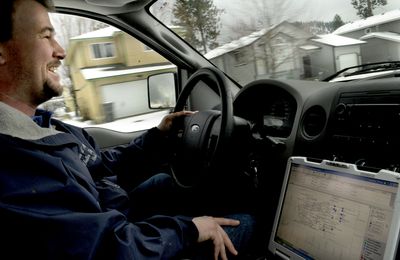No more door-to-door
Radio signals let Water Department quickly assess usage

The city of Coeur d’Alene Water Department’s walking route to record every residence’s H{-2}O meter will soon become a way of the past.
For several decades, the department relied on a crew that trekked around town to the backyards, basements and porches of each home and business within city limits – in total, more than 17,000 units. In recent years, that route took a three-person team two months to check all the meters spread around the Lake City, meaning residents would receive a hefty water bill every two months.
That all started to change in June 2005, when the Water Department began investing in a new wireless meter-reading technology in a digital transition of a different sort. Attached to each building’s Badger-brand water gauge with a wire, the new, cylinder-shaped device is mounted to an adjacent wall or outside exterior in about 15 minutes and emits an automatic radio signal every four seconds. Now, instead of walking meter-readers that go house-to-house, Water Department employees can just drive by a home and pick up the signal with a laptop computer.
“It’s really quite the unique unit,” said Terry Pickel, assistant superintendant of the Water Department. “Here, they had the unique situation where it took meter-readers two months solid to read them all. Doing the radio reads, it shortens the time; now we can do it in two weeks.”
The wireless transmitter, which is dubbed Orion and fits inside a pint glass, is the latest in wireless meter-reading technology, and it’s been used in other towns around the area – like Sandpoint – for several years. A similar but less high-tech system has been on the market for almost 15 years, but the new wireless system comes future-ready, including with the latest easy-to-use software programs, a dash-mounted GPS tracker for each computer-equipped vehicle and a 20-year battery in each transmitter. And, if Coeur d’Alene ever launches a citywide Wi-Fi network, the Water Department can collect the signals automatically without even leaving the building.
The total price tag to update each water meter will be about $2.4 million, which Pickel said was funded entirely through rate-payer fees.
“With the growth of Coeur d’Alene, it’s pretty much paid for itself,” he said, adding that, while the citywide upgrade isn’t inexpensive, “it will save that over the lifetime of the units in labor.”
About the department’s decision to go with the Badger-brand Orion system, Utility Supervisor Rob Stark said, “We’ve done our homework.” Dalton Gardens also is working on installing a similar system.
As Stark prepared to drive around a several-block path just southwest of the Water Department’s headquarters, a route that used to take meter readers a day, the console-mounted laptop displayed an outline of all the homes that would be recorded. A triangle on the screen indicated the truck’s position in the parking lot.
“The old route takes about five minutes now,” he explained.
In addition to the reduced recording times, Stark offered some other benefits of going with the wireless system. It eliminates possible human error in reading the meters by foot, he said, adding “this way, it is what it is and there are no mistakes.”
Also, if there is a leaky faucet or burst pipe in a home, the Water Department can much more quickly notify a homeowner to prevent further damage. “So it’s a good indicator for us if a homeowner has a leak and we can try to save them some money,” he said.
The wireless devices have been installed in roughly 13,000 buildings. The Water Department is hoping to update the remaining 4,000 meters, primarily located in the downtown area, by late August, Pickel said.